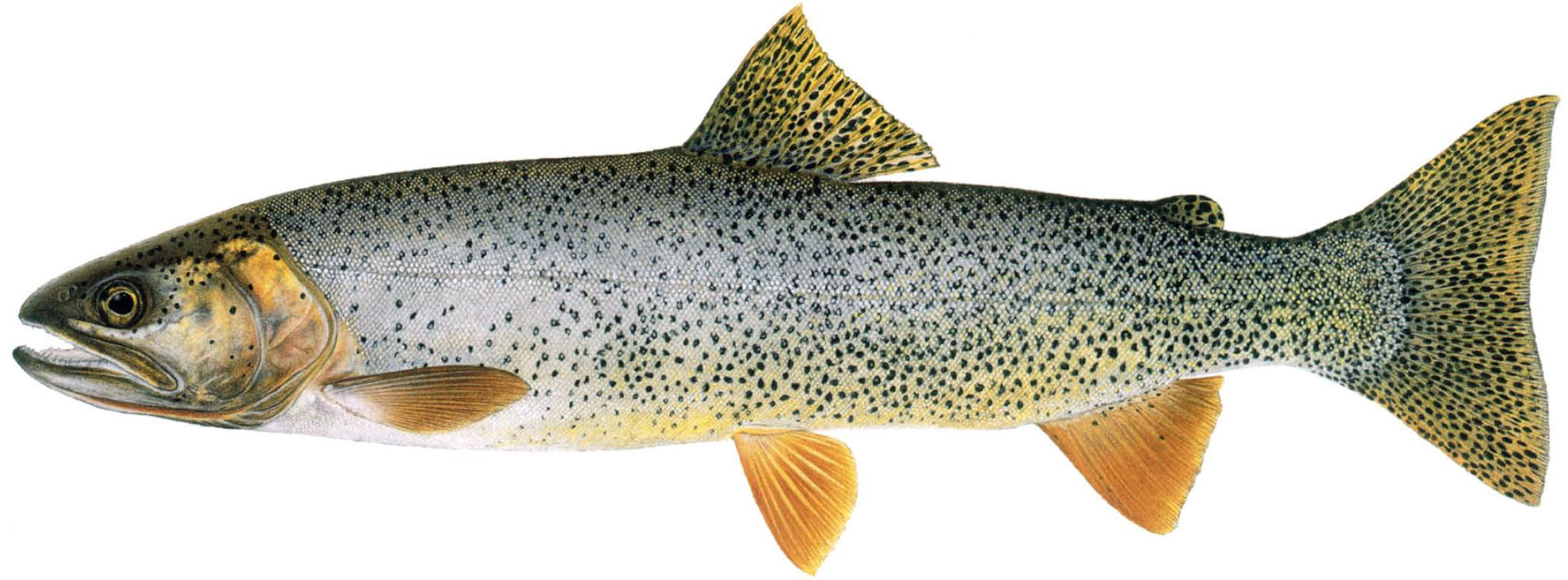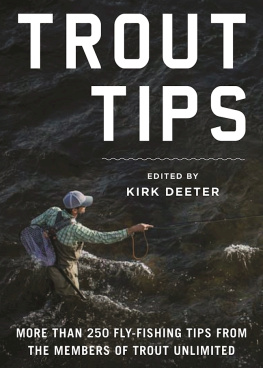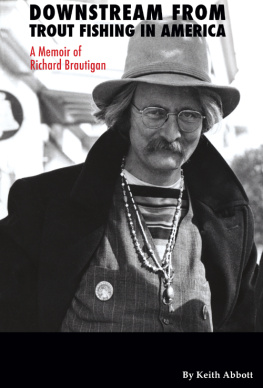Robert Behnke - Trout and Salmon of North America
Here you can read online Robert Behnke - Trout and Salmon of North America full text of the book (entire story) in english for free. Download pdf and epub, get meaning, cover and reviews about this ebook. publisher: Free Press, genre: Romance novel. Description of the work, (preface) as well as reviews are available. Best literature library LitArk.com created for fans of good reading and offers a wide selection of genres:
Romance novel
Science fiction
Adventure
Detective
Science
History
Home and family
Prose
Art
Politics
Computer
Non-fiction
Religion
Business
Children
Humor
Choose a favorite category and find really read worthwhile books. Enjoy immersion in the world of imagination, feel the emotions of the characters or learn something new for yourself, make an fascinating discovery.

- Book:Trout and Salmon of North America
- Author:
- Publisher:Free Press
- Genre:
- Rating:5 / 5
- Favourites:Add to favourites
- Your mark:
- 100
- 1
- 2
- 3
- 4
- 5
Trout and Salmon of North America: summary, description and annotation
We offer to read an annotation, description, summary or preface (depends on what the author of the book "Trout and Salmon of North America" wrote himself). If you haven't found the necessary information about the book — write in the comments, we will try to find it.
Trout and Salmon of North America — read online for free the complete book (whole text) full work
Below is the text of the book, divided by pages. System saving the place of the last page read, allows you to conveniently read the book "Trout and Salmon of North America" online for free, without having to search again every time where you left off. Put a bookmark, and you can go to the page where you finished reading at any time.
Font size:
Interval:
Bookmark:
Thank you for downloading this Simon & Schuster ebook.
Get a FREE ebook when you join our mailing list. Plus, get updates on new releases, deals, recommended reads, and more from Simon & Schuster. Click below to sign up and see terms and conditions.
CLICK HERE TO SIGN UP
Already a subscriber? Provide your email again so we can register this ebook and send you more of what you like to read. You will continue to receive exclusive offers in your inbox.
We hope you enjoyed reading this Simon & Schuster ebook.
Get a FREE ebook when you join our mailing list. Plus, get updates on new releases, deals, recommended reads, and more from Simon & Schuster. Click below to sign up and see terms and conditions.
CLICK HERE TO SIGN UP
Already a subscriber? Provide your email again so we can register this ebook and send you more of what you like to read. You will continue to receive exclusive offers in your inbox.

SNAKE RIVER FINESPOTTED CUTTHROAT TROUT
Oncorhynchus clarki behnkei


THE FREE PRESS
A DIVISION OF SIMON & SCHUSTER INC.
123O AVENUE OF THE AMERICAS
NEW YORK, NY 10020
WWW.SIMONANDSCHUSTER.COM
COPYRIGHT 2002 BY CHANTICLEER PRESS, INC.
ILLUSTRATIONS COPYRIGHT JOSEPH R. TOMELLERI
FOREWORD COPYRIGHT THOMAS McGUANE
ALL RIGHTS RESERVED UNDER INTERNATIONAL AND PAN-AMERICAN COPYRIGHT CONVENTIONS.
PREPARED AND PRODUCED
BY CHANTICLEER PRESS, INC., NEW YORK AND CHARLES NIX 8c ASSOCIATES
FIRST EDITION
PUBLISHED OCTOBER 2002
THE FREE PRESS AND COLOPHON ARE TRADEMARKS OF SIMON 8c SCHUSTER, INC.
LIBRARY OF CONGRESS
CATA LO GING-IN-PUBLIC AT ION DATA
Behnke, Robert J.
Trout and salmon of North America /
Robert J. Behnke ; illustrated by Joseph R. Tomelleri ;
foreword by Thomas McGuane.1st ed.
P. CM.
Includes bibliographical references.
1. TroutNorth America. 2. SalmonNorth America. I. Tomelleri, Joseph R. II. Title.
QL638.S2 B432 2002
597-57097DC21 2002069256
ISBN: 0-7432-2220-2
ISBN: 978-1-4516-0355-2 (eBook)
FOR INFORMATION ABOUT DISCOUNTS
FOR BULK PURCHASES, PLEASE CONTACT
SIMON & SCHUSTER SPECIAL SALES: 1-800-456-6789
OR
Thomas McGuane
Trout and Salmon of North America is as much a celebration as a guidebook. The mystery and particularity of so many members of a great family, brilliantly described and handsomely portrayed, enlarge our capacity for wonder: rainbow trout of the Mexican highlands living on terrestrial insects, rainbows of Kodiak Island gorging on sockeye eggs, brown trout in the suburbs of New York, Atlantic salmon born in Connecticut feeding under the pack ice of Greenland, Pacific salmon returning to natal rivers in a kaleidoscope of physical change, brook trout sipping midges in Appalachia or in the pristine waters of Labrador, steelhead from a chaparral-crowded California creek navigating the Gulf of Alaska, Chinook salmon killing wolf eels in the deep North Pacific are all cousins whether found in boreal forest, tundra, desert, alpine lakes, or mid-ocean. These great and diverse species of fishes with which we live may yet be better understood thanks to this elegant book.
Raising public awareness about fishes is a greater challenge than it is for birds. Fish dont come to the feeder. We cant watch them with binoculars. They dont migrate over our roof or identify themselves through song when they cant be seen. Nevertheless, because most of mankind lives next to seas and rivers, fish subsist in real proximity to us and are, in countless ways, our dependents. Yet they live in great mystery.
Naming, describing, classifying, and, in general, accounting for fish is the business of taxonomy and it is strenuous duty. Driven by such intangibles as philosophy and judgement, taxonomy is not quite, and is more than, a science. Imagine accurately describing fish that, after half a million years in a specific biome, have by the time of the arrival of Europeans in North America been reduced to one or two museum specimens preserved in a jar. Such miracles of resurrection have actually been achieved in this book.
Glaciation, millennial drought, ancestral invasions, tectonic shift, plate migration, ancient isolation of basins, headwater interbasin transfers, ice dams, lava flows, lakes and landslide ponds, interference by well-meaning men with mules and milk cans transporting baby trout to places trout had never beenhistories of separation and combination often involve co-evolution with other species over timescapes of a million years and are only recently beginning to be unwound in the maps of genes. These studies are eternally compromised by the simple fact that even molecular genetics is not a certain predictor of morphologies or life histories.
Evolutionary relationships sometimes contradict external traits. The profusion and placement of spots, numbers of vertebrae, parr marks, bands, colors, fin shapes, run timing, number of scales, and kinds of teeth all can lead the taxonomist toward or away from the truths of a species history. Is this fish lacustrine, fluvial, resident, or sea-run? Is the steelhead a trout or a salmon? Did the cutthroat give rise to the rainbow? Should we view rare stocks as heritage trout? How should we manage a small creek that arises from a spring and vanishes in its own streambed, appearing to the ignorant as an innocuous ditch, but containing a population of trout that has remained uncontaminated for thousands of years? Will we ever thoroughly understand how the magnetite in the noses of trout and salmon supplies geographical data for celestial navigation? How do we quantify the risk of extinction? And where do we place beauty? Or that ghost chorus of departed species?
The very names of our salmonids tie us to other peoples: the Koryak of Kamchatka, the Kootenay, the Inuit. They had the idea of these fish first and deserve consultation in their management. When we built Grand Coulee Dam and disfigured our own heritage by destroying a thousand miles of streambed salmon habitat, consultation with these forebears as to the eternal aspect of wild things might have played to our long-term advantage and led to a real accounting as to our wealth as a people. Weve been thinking about our salmonids for a long time. They were first described by a member of the Coronado expedition; Lewis and Clark first took note of the cutthroat trout; and General Crook chose to angle for them while his colleague Custer fell at Little Big Horn. Its time we embraced them in their bounteous variety.
The rise of mankind has been a calamity for the natural world as there becomes less room for everything but man. Loss of habitat comes first, of course; then, the Four Horsemen of the Apocalypse: livestock grazing, logging, mining, and irrigation. Our attempts to overrule evolutionary isolation through fish culture, while well meaning, have abrogated adaptational strategies and increased vulnerability to disease and event-specific catastrophe. Against a great and stirring timescape in ancestral headwaters, the diversity of fishes has been a cascade of jewels, while indiscriminate hybridization has produced a besetting and assailable uniformity. It is urgent that we place value upon diversity so that its loss can be reckoned as cost. Robert Behnke says it here best: All hereditary changes brought about by artificial selection for more efficient rearing in fish culture are contrary to natural selection, where the sole criterion is survival to reproduction in the wild. In issues of resource management, the expenditure of diversity should appear on the balance sheet as the gravest entry of all.
Font size:
Interval:
Bookmark:
Similar books «Trout and Salmon of North America»
Look at similar books to Trout and Salmon of North America. We have selected literature similar in name and meaning in the hope of providing readers with more options to find new, interesting, not yet read works.
Discussion, reviews of the book Trout and Salmon of North America and just readers' own opinions. Leave your comments, write what you think about the work, its meaning or the main characters. Specify what exactly you liked and what you didn't like, and why you think so.









